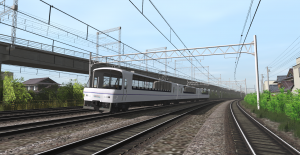
All the necessary dependencies are included in this .rar, included or are avaible on the DLS.
DOWNLOAD
The JR West 213 Series pack is required for some consists.
This lone 3-car set was built in 1988 for services on the Seto-Ooashi Line, via the newly-opened Great Seto Bridge. It is basically a self-propelled version of the KuRo 212 panoramic cab cars for Marine Liner trains, built at the same time and with the same design. Unlike the KuRo 212 cars, wich were intended to be an attractive “addition” to the otherwise conventional 213 Series trains, the Super Saloon Yumeji was intended to be tourist-charter train hybrid, taking full advantage of the panoramic wiews offered by the Seto strait crossing.
The Super Saloon Yumeji was manufactured by Kinki Sharyo and consisted in two powered cab cars (one of wich was fitted with a pantograph) of a design nearly identical to the KuRo 212 cars (also manufactured by Kinki Sharyo) sandwitching a power car built to the same design. However, unlike the KuRo 212 cars, wich were limited to “warm areas”, the Super Saloon Yumeji was designed to be able to run all over JR West’s DC-electrified network and therefore was fitted with snow-resistant equipment and had a maximium speed of 120 Km/h (whereas the KuRo 212s, as trailers for the 213 Series, had a maximium speed of 110 Km/h).
Upon it’s entrance in service in 1988, the Super Saloon Yumeji was classified as a 211 Series train by JR West. This might seem odd, however it has an explanation: given that the Super Saloon Yumeji was intended to be a “stand-alone” set, it was decided to classify it as part of the 211 Series instead of the 213 Series to avoid confusion between the two. However the Super Saloon Yumeji shared the entirety of it’s techical components with the 213 Series (and by extension also the “proper” 211 Series as well), with the two trains being mutually compatible.
While the set was intended for tourist and charter services, due to the overcrowding problem on Marine Liner services it wasnt uncommon to see the Super Saloon Yumeji set being “dismembered” and mixed into a 213 Series formation. Thanks also to the fact that the Super Saloon Yumeji and the 213 Series shared the entirety of their technical equimpents, it wasn’t also uncommon to see the set’s KuMoRo 212 non-pantograph cab car being used interchangeably with the KuRo 212 cab cars “proper” of Marine Liner trains. Sometimes even the whole Super Saloon Yumeji was also used to run Marine Liner services, of course due to the limited capacity, during off-peak hours.
With the retirement of the 213 Series from Marine Liner services in 2003, the Super Saloon Yumeji also stopped running those services, now being used exclusively for it’s intended charter train purpose, being used, among other things, regularily on New Years’ Day on special services between Okayama and Kotohira. However, the usage of the set declined thruought the years, and in 2010 JR West decided to retire it. The Super Saloon Yumeji made it’s final run on the 7th of March 2010.
Unfortunately, one month after it’s retirement, the whole set was packed and sent to JR West’s Suita workshops to be scrapped.
Trivia #1:
While the Super Saloon Yumeji is classifed as a 211 Series set as a “whole”, only the KuMoRo 211 (the cab car with pantograph) and MoRo 210 (the intermediate car) are also officially classified into the 211 Series – the third car, KuMoRo 212 is actually classifed as part of the 213 Series.
Trivia #2:
On the 10th of April 1988 the Super Saloon Yumeji officially inaugurated the Seto-Ooashi Line, carrying the then-crown prince Akihito and crown princess Michiko (later emperor and emperess, and current emperor and emperess emeritus).
Trivia #3:
The cab cars of the Super Saloon Yumeji were fitted with Karaoke machines for usage on charter trips.
